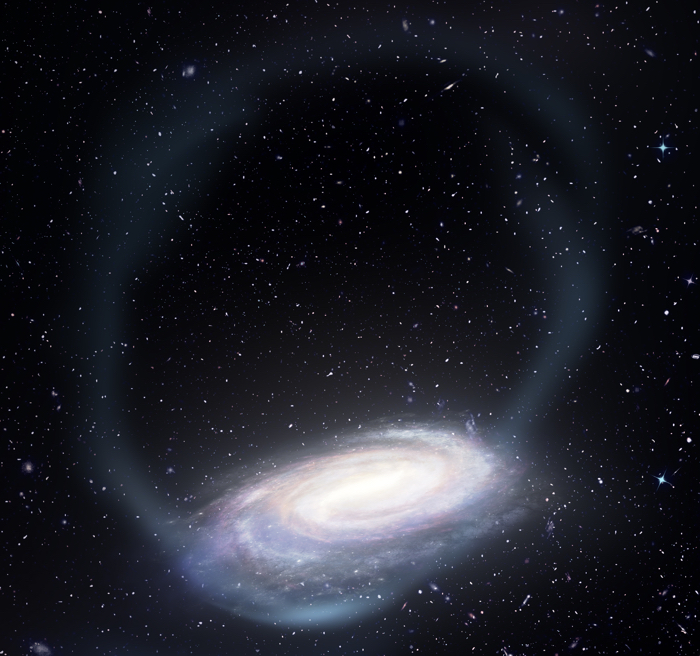Astronomers have discovered a mysterious stream of ancient stars at the distant edges of the galaxy: a strange stellar breed so unlike any we've seen before, they may very well be the last of their kind.
This unusual collection of stars – called the 'Phoenix stream', after the Phoenix constellation in which they are visible – is what's known as a stellar stream: an elongated chain of stars that used to exist in a spherical form, known as a globular cluster.
Such clusters can be torn asunder by a galaxy's gravitational forces, in which case their globular form becomes warped, stretching out into a ghostly caravan of stars, fated to distantly orbit a faraway galactic core.
 (James Josephides/Swinburne Astronomy Productions/S5 Collaboration)
(James Josephides/Swinburne Astronomy Productions/S5 Collaboration)
Above: Artist's impression of the stellar stream wrapping around the Milky Way.
Neither stellar streams nor globular clusters are new to science, but there's something about the Phoenix stream that is. Its chemistry is different to any globular cluster we've ever seen, almost like it doesn't belong here.
"We can trace the lineage of stars by measuring the different types of chemical elements we detect in them, much like we can trace a person's connection to their ancestors through their DNA," explains astronomer Kyler Kuehn from the Lowell Observatory in Arizona.
"It's almost like finding someone with DNA that doesn't match any other person, living or dead."
There are around 150 known globular clusters in the Milky Way, all of which exist in what's called the galactic halo – a tenuous spherical structure that envelops the relatively flat galactic disk, where most of a galaxy's stars otherwise congregate.
Out in the fringes of the halo, though, there are still plenty of stars assembled inside the globular clusters. Each cluster can contain hundreds of thousands of stars, and observations of the clusters in the Milky Way have shown that all clusters demonstrate a certain consistency in their stellar chemistry: the stars in the clusters are enriched with 'heavier' chemical elements that are more massive than hydrogen and helium.
After the Big Bang, theory holds that all the gas in the Universe was made up of either hydrogen or helium, which in turn formed the Universe's first stars. Other elements, such as oxygen, carbon, and magnesium, only became possible much later via the fusion mechanisms of subsequent generations of stars.
The chemical legacy of those later fusion mechanisms is all around us, as a certain proportion of heavier elements has been observed in all our galaxy's globular customers. That is, until now.
This chemical threshold – called the metallicity floor – is not obeyed by the Phoenix stream, which demonstrates less heavy elements in its stars than we thought was theoretically possible for such a celestial structure.
"This stream comes from a cluster that, by our understanding, shouldn't have existed," explains astronomer Daniel Zucker from Macquarie University in Australia.
Or at least, it shouldn't exist now, could be another way of putting it.
Observations of the Phoenix stream conducted by an international team of researchers as part of the Southern Stellar Stream Spectroscopic Survey Collaboration have revealed that its "metal abundance is substantially below the empirical metallicity floor", the authors explain in their new study.
Up until now, the metallicity floor was a useful way of classifying a scientific constant seen across all present-day globular clusters. It still is, as it happens – but the Phoenix stream is no present-day globular cluster.
The team thinks it may be a sole survivor: a celestial relic of a bygone age in the early Universe, when stars made their light in different ways.
"One possible explanation is that the Phoenix stream represents the last of its kind, the remnant of a population of globular clusters that was born in radically different environments to those we see today," says astronomer Ting Li from Carnegie Observatories in Pasadena.
Lots of questions remain, of course. If the Phoenix stream is a remnant of a relic from the early Universe, is it the only one? Do others also exist, hidden in the vastness of the galactic halo?
"In astronomy, when we find a new kind of object, it suggests that there are more of them out there," says astronomer Jeffrey Simpson from the University of New South Wales (UNSW) in Australia.
If other old travellers are still on the trail, we don't have forever to find them. Like globular clusters, stellar streams are not immortal things. Once they're stretched out into a string of stars, it's only a matter of time before they disband, and disperse throughout the galaxy.
"Who knows how many relics like the Phoenix stream might be hiding in the Milky Way's halo?" wonders German astronomer J. M. Diederik Kruijssen from Heidelberg University, who wasn't involved in the study but has authored a commentary on it.
"Now that the first one has been found, the hunt is on."
The findings are reported in Nature.
#Space | https://sciencespies.com/space/astronomers-find-stream-of-early-universe-stars-torn-apart-by-our-own-galaxy/
No comments:
Post a Comment